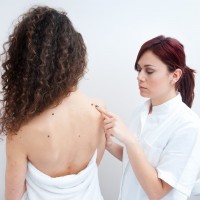
Moles are usually harmless, but these small dark spots on our skin can sometimes develop into a type of skin cancer known as melanoma. Melanoma can be very serious if it isn’t spotted and treated quickly, so it is important to keep a close eye on your moles and to see a doctor if you notice changes or anything unusual.
Noticing that one of your moles is changing can be worrying, but it is important to remember that most moles won’t cause any problems and most people won’t be affected by skin cancer. Melanoma is relatively rare. But take steps to protect yourself – check your moles regularly and make sure that you’re protecting yourself from sun damage as this can increase the risk of skin cancer.
How Can Moles Cause Problems?
A mole is a small area on your skin that has more pigment-producing cells than normal, making it appear darker. Generally, these cells are harmless, but they can sometimes develop abnormalities that make them grow and divide more than normal and can then become cancerous. These abnormalities are often triggered by sun damage.
Melanoma is one of the more serious types of skin cancer because it is more likely to grow quickly and has the propensity to spread to other parts of the body. It is therefore vital to spot the signs of melanoma as soon as possible so that it can be removed early.
How to Check Moles for Skin Cancer?
Moles are very common and some of us have them in vast numbers. Set aside some time every few months to check your skin. Take a close look at all of your moles, using a mirror or asking a friend to help check any moles in hard to see places. You might want to take photos of your moles so that you can keep track of any changes. You should look out for any of the following signs that could indicate that a mole could be abnormal.
It is also important to check the rest of your skin too, as skin cancer doesn’t always develop within moles. If you notice anything unusual, consult a dermatologist.
Signs of Skin Cancer in Moles
Moles can have quite a variable appearance. Often, they look like small, dark, round marks on your skin that can be flat or raised. Sometimes they have hair growing from them and sometimes they can be skin-coloured. If you notice that one of your moles is changing quickly in any of the following ways then consult a dermatologist.
You should be concerned about a mole that is:
- Growing
- Changing in colour
- Becoming less symmetrical
- Developing a blurred border
- Crusty or bleeding
- Appearing where there wasn’t a mole there before
- Changing in any other way
Check your moles regularly so that you can spot any signs of trouble as soon as possible. Being more familiar with your moles will also enable you to detect any changes in them early. Look out for the ‘ugly duckling’ mole that stands out from all of the others – perhaps it is larger or darker than the rest.
Other Risk Factors for Melanoma
Anyone can be affected by skin cancer, but you are more likely to develop melanoma if:
- You have lots of moles (more than about 50), as melanoma is more likely to develop within moles
- Lots of your moles are unusual looking (e.g. asymmetric or irregular shaped)
- You have a fair complexion that burns very easily in the sun
- You spend a lot of time outdoors in the sun
- You’ve had sunburn or tanned a lot in the past
- You’ve used sunbeds in the past
- You don’t regularly use sunscreen or other forms of sun protection
- Another member or members of your family has/have been affected by melanoma, particularly at a young age
If any of these factors apply to you, you should be particularly careful to protect yourself from the sun and to check your moles regularly.
When to See a Doctor About a Mole?
If you notice any suspicious changes in a mole then you should see a doctor as soon as possible. The dermatologist will make a detailed assessment of your skin and risk factors and may recommend removing it. Once the mole has been removed, it will be tested in the lab to confirm whether it was cancerous and that all of the cancer cells have been removed. As long as melanomas are treated quickly, it should be possible to remove the whole tumour so that it won’t cause any problems.
In about 75% of cases, there won’t be any need for further treatment once the mole has been removed. Sometimes, additional treatment will be required to eliminate any remaining cancer cells. In a small number of cases, the cancer will have spread to other parts of the body before it was detected. Treatment can still help, but melanoma can be fatal if it isn’t treated promptly.
Do see a dermatologist if you have concerns about your moles. A skin check can be hugely reassuring and is an opportunity to get professional advice on how to check your moles and protect your skin.
What to Expect at the Appointment
When you visit the clinic to have a mole or an unusual change in your skin checked, the doctor will take a close look at your skin and ask about the changes you have noticed. The doctor may also ask about your sun exposure, particularly if you’ve often been burned or if you’ve used tanning beds, if you’ve had skin cancer in the past or if there’s a history of it in your family.
The most likely outcome is that the doctor will tell you there is nothing to worry about. However, you shouldn’t feel like you are wasting anyone’s time. It’s important for any unusual skin changes to be checked by a doctor, just in case. If your doctor does think there is cause for concern, skin cancer can often be treated simply by removing the mole or growth. The treatment will be most successful and least invasive when the problem has been detected early, so it’s always worthwhile getting your moles checked.


